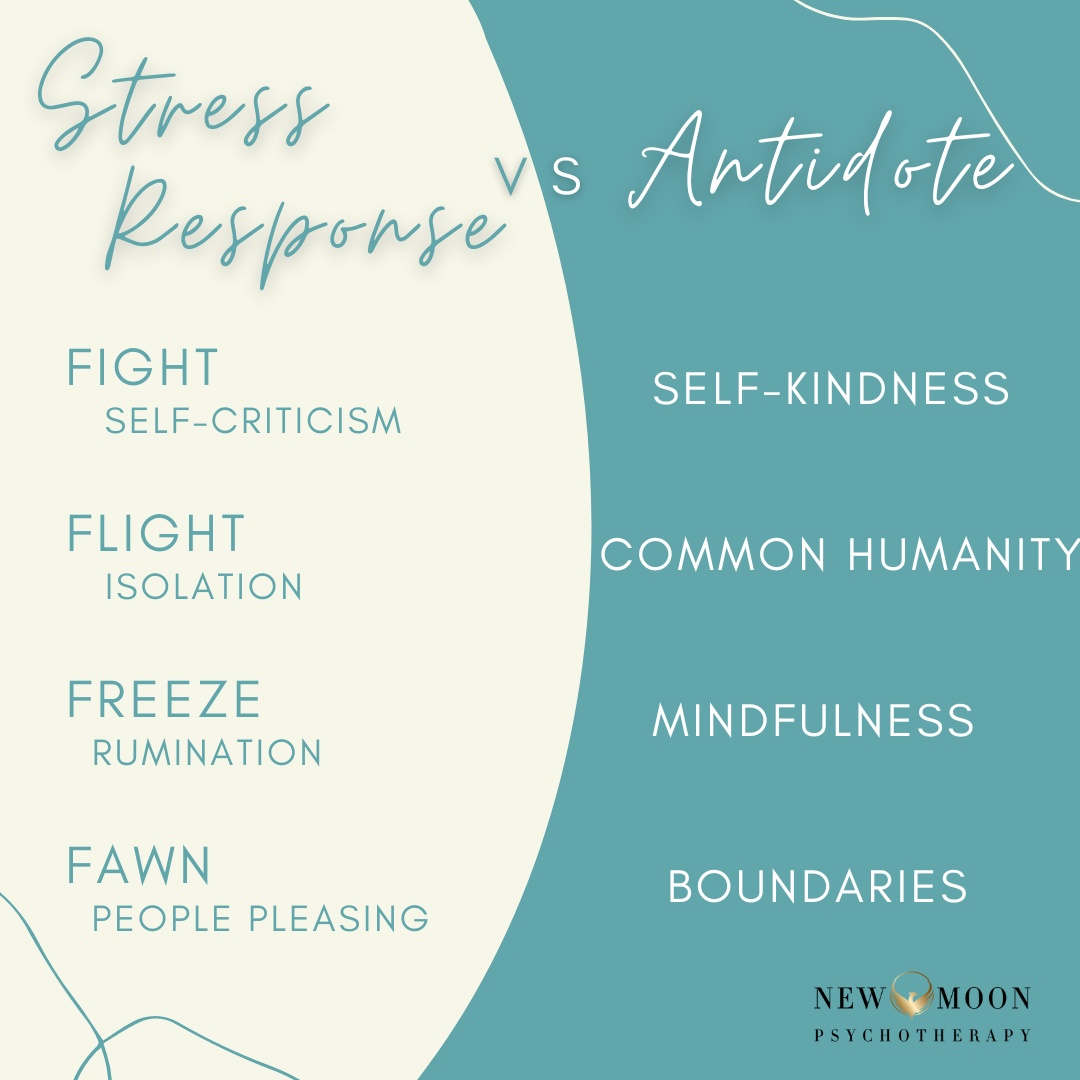Self-Compassion as an Antidote to the Stress Response

In our last blog we discussed the trauma response – fight, flight, freeze, fawn. The trauma response is a survival instinct that dictates how we will act when we are faced with a highly distressing and life-threatening situation (eg. physical/emotional/sexual abuse, accident, natural disaster, etc.). However, this response tends to linger and recur when we are faced with stressful, but not life threatening or distressing, situations once the traumatic experience is no longer a threat (eg. You’re home after an accident, you’re no longer being abused, found safety after a disaster, etc.). In these cases, the stress response is often turned inwards.
We fight ourselves, we fee from others, we freeze, and we people please. The good news is that there is an antidote for this response – self-compassion. In this blog we will discuss how the fight, flight, freeze, and fawn stress response turns inwards and the antidotes or strategies that we can use to create safety and stability.
Fight vs. Self-Kindness
Turned inward, the fight response becomes self-criticism. Trauma survivors often find themselves engaging in self-criticism first around the traumatic event – “I should have done something differently” “It’s my fault” “I could have fought harder”, etc.
Self-criticism also generalizes to other areas of their lives. Often survivors are intolerant of their own mistakes – considering them to be failures instead of opportunities for growth. They tend to hold themselves to a high or even unrealistic standard which naturally becomes distressing, interferes with relationships, personal growth, and general wellbeing.
We fight the fight response through self-kindness. Self-kindness is the opposite of beating ourselves up. It’s showing ourselves encouragement, care, warmth, and unconditional acceptance. It’s also being soothing and comforting with ourselves.
Self-kindness can be verbal – such as saying “you’re allowed to take time” “of course this is upsetting” “you did your best” “how amazing that you even tried”. It can also be physical – gently rubbing your arm, giving yourself a hug, or placing a hand on your heart. Self-kindness can also involve self-soothing and comforting – we can do this through our five senses by tuning into those senses and doing something gentle such as looking at images or smelling something that brings us comfort.
Flight vs. Common Humanity
Turned inward, the flight response becomes isolation. Often trauma survivors believe they need to hide from others and to not show their true selves because they believe that there is something wrong with them, that others won’t understand, and that others will figure out that they don’t fit in. This generalizes to different areas of their life – for example, if they are in pain, if a mistake is made, or if things don’t go to plan, they try to isolate and withdraw (sometimes even before something goes wrong as a preventative factor).
Ultimately, this reasoning is flawed. Pain and mistakes are a fact of life for everyone. It’s one of the most common human experiences. By reminding oneself of the common humanity in ones experience, our distress lessons, w move out of isolation, and create opportunities for connection.
Freeze vs. Mindfulness
Turned inward, the freeze response becomes rumination. It can be rumination about the traumatic event, what occurred, how it could have been different. It can also be rumination about other things in life – Did I lock the door? How did others perceive me? Did I do something right? What did that subtle change in facial expression mean?
Because rumination is past and future oriented it makes it impossible to live in the moment. Mindfulness is it’s antidote.
Mindfulness is not what you think – it is not sitting by the ocean, legs crossed, index and thumb together. Mindfulness is about being fully present and aware of what is happening in the moment without trying to change it or push it away – including our thoughts, emotions, and sensations.
Fawn vs. Boundaries
And finally, the fawn response turned inward becomes people pleasing. This can be seen in countless ways. It can be saying yes when you want to say no, putting others physical, emotional, and sexual needs above your own, accepting others’ opinions and values in place of your own, and feeling responsible for other people’s happiness. Fawning blurs the line between where we end and another person begins and can create difficulties in our personal and social lives.
Boundaries reinstate that line and create clarity, choice, and opportunities for healthy relationships. When you haven’t been taught boundaries, or learned that boundaries got you in trouble, setting boundaries can feel difficult, overwhelming, and unnatural. This is normal and with assistance it IS possible to transform your boundaries into healthy ones.
More often than not, survivors experience some difficulties with each of these four areas. This is where regularly practicing self-kindness, common humanity, mindfulness, and boundaries is essential to growth and a satisfying and fulfilling life following a traumatic experience. If you’re struggling in either of these areas and want support, NMP has a variety of clinicians who can help.

